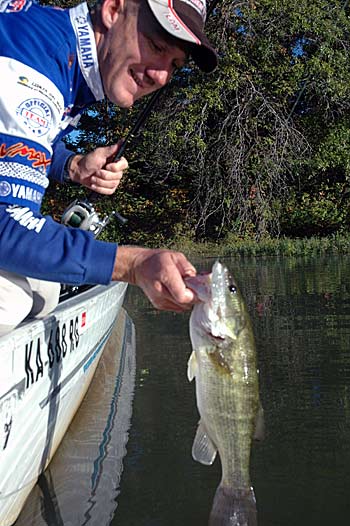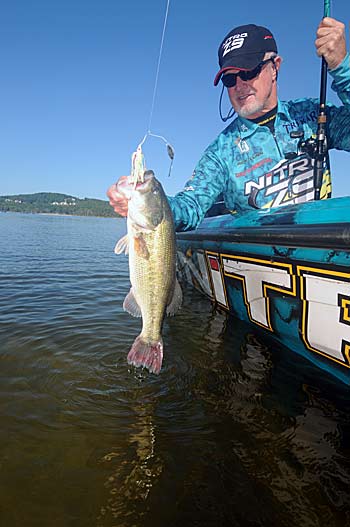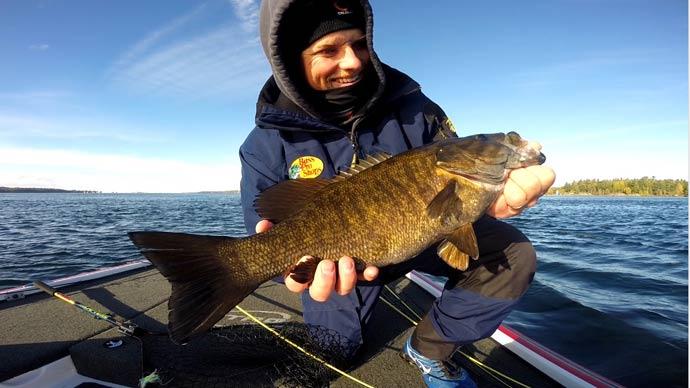
When a restaurant specializes in a particular food, customers usually order that entrée for dinner.
So, if an establishment is known for its seafood, it is doubtful that the waiter will try to talk you into ordering a hamburger.
The same holds for bass when they gorge on their fall feast. Shad are a bass' primary forage in autumn, so your best choice would be to serve them something that mimics their favorite fall meal. When you present your lure to bass in any way similar to that of a fleeing shad, your offering is akin to ordering lobster at your favorite seafood restaurant.
Touring pros can trick fall bass into eating their shad imitators with the following five techniques.
Buzzing A Frog
Whenever he fishes matted or submerged vegetation in the fall, Kansas pro Brent Chapman prefers a silver-flake Zoom Horny Toad rather than a buzz bait for running over the weeds. “It is way more consistent,” says Chapman. “It doesn’t ball up in the vegetation like a buzz bait does.”
The Major League Fishing (MLF) pro slips a glass bead on his line and ties on a 5/0 Trokar TK160 hook to stick into his frog. He secures the glass bead before the frog's nose with a bobber stop to prevent slime from balling up on the hook eye and knot.
With the frog running steadily to keep its legs flapping on the surface, Chapman targets both the surface mat and the weed edges. "That is just something you have to experiment with because sometimes half of the fish are in the thick stuff and half are on the edges," says Chapman.
Speeding Up Spooks
The tantalizing slow zigzag of a Zara Spook usually triggers strikes, but Zell Rowland turns up the speed on his topwater offerings in the fall. "The faster the speed of the bait, the more aggressive the fish seem to get," he says. "That time of the year, bass tend to be chasing a lot of baitfish . . . when I see that kind of activity, I want my bait to match what those fish are looking at."
The Texas pro fires his Zara Spook past any busting activity he spots and proceeds to jerk the lure at a swift pace. "It will sort of walk from side to side, but instead of the bait having an 80- to 90-degree turn in the water, it will have about a 10-degree or less turn," Rowland says. "It almost looks like the bait is coming straight at you without any side movement. It also throws tremendous water and makes the fish want to get on it."
Lipless Cranking
“There are few baits that you can burn as effectively as a lipless crankbait,” says former Bassmaster Classic champion Alton Jones. "Some days, there is no such thing as too fast. They want it so fast that I feel numb because I am reeling so fast."
The Texas pro favors a lipless crankbait over a square-bill model sometimes because the lure sinks rather than rises during a pause in the retrieve. The sinking lure allows him to constantly bang off the rocks of a riprap bank or steeper rocky shoreline in the backs of creeks. Positioning his boat parallel to the bank, Jones keeps his crankbait speeding along in water less than 5 feet deep throughout his retrieve.
A chrome-and-blue 1/2-ounce lipless crankbait is Jones’ favorite rattle bait for running rapidly over the rocks. If he notices smaller shad in the area he’s fishing, Jones scales down to a 1/4-ounce version to match the size of the forage.
Swimming A Jig
A swim jig offers bass a different shad look in the fall for finicky bass.
“Sometimes they don’t want a big profile bait like a spinnerbait because of weather changes or whatever, but they will take something more streamlined like that swim jig,” says regional tournament veteran Jim Lovan. "You can do so many different things with it. You can pop it, swim it, and vary the retrieves."
The Missouri angler favors a white 3/8-ounce swim jig tipped with a white Zoom Super Chunk for pitching around ambush points such as large rocks, laydown logs, and standing timber. The swim jig is especially effective for big bass holding under the floatation of boat docks.
Lovan keeps the swim jig less than 2 feet below the surface by constantly reeling and twitching his rod tip. "I periodically kill it to let the jig fall and then bring it back up," says Lovan. Strikes usually occur when he pauses the retrieve along the corners of docks or the edges of large rocks or logs.
Waking A Spinnerbait
Image
B.A.S.S. legend imitates fleeing shad by waking a spinnerbait in the fall. B.A.S.S. legend Rick Clunn lists waking a spinnerbait as his favorite way to catch bass in the fall because the high-speed retrieve triggers such vicious reflex strikes.
Although a fast pace is required for waking a blade bait, the speed of the retrieve must also be controlled. The key to the retrieve is to reel fast enough to make the blade wake the water behind it but not too fast to where the blade breaks the surface.
Combining the right lure weight and blade size is essential to waking a spinnerbait. "Any time you are waking, you have to maintain the balance between the blade's pull and the head's weight," says Clunn. "If the blade is too big, it will overpower the head and try to pull it over." The Missouri pro suggests putting more weight on the head of the lure or switching to shorter blades if your spinnerbait continues to roll during a high-speed retrieve.
A spinnerbait can be waked with any blade, but Clunn prefers a unique spinner that he calls a long drop blade (a cross between an Indiana and a willowleaf blade). Clunn also favors a 3/4-ounce spinnerbait because he believes the heavier lure tracks better in the water than the 1/2-ounce models most anglers use for waking.
The first step to waking a spinnerbait is to make a long cast to prevent spooking fish and trigger strikes at the far end of the presentation. Clunn begins his retrieve with his rod at the 10 o'clock position, and he continues to lower his rod as the lure gets closer to the boat. The lower rod angle prevents the spinnerbait from pulling up and keeps the blades from breaking the surface at the end of the retrieve. "The more it wakes all the way back, the better off you are,” Clunn says.
When shad are the special-of-the-day on the fall menu, ensure you whet a bass' appetite with one of these baitfish imitating treats.
You can get additional tips like these from the author’s book, “101 Bass Fishing Tips, Twenty-First Century Bassing Tactics and Techniques from All the Top Pros.” Order an autographed copy by visiting https://jnoutdoors1.jnoutdoors.com.




